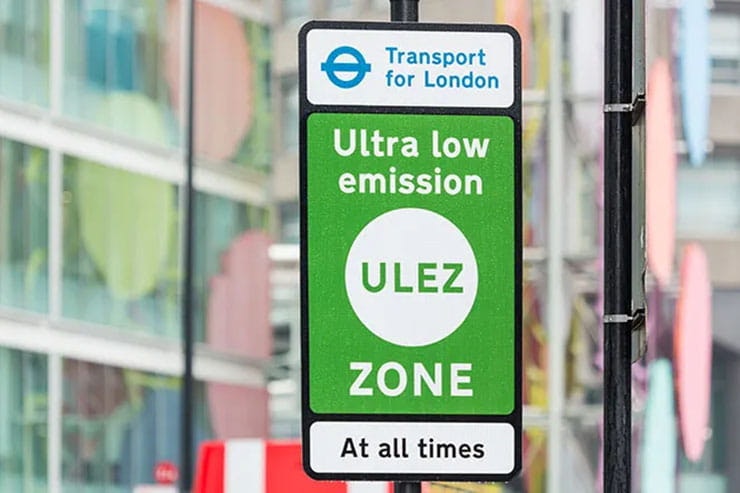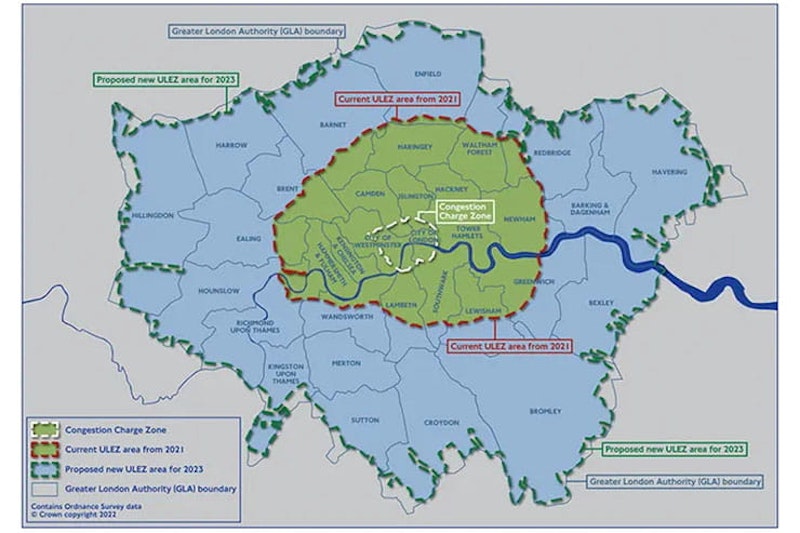Expanded London ULEZ zone: all you need to know
By Ben Purvis
Motorcycle Journalist
30.08.2023
London’s controversially expanded ULEZ charge has come into force this week (30th Aug 2023) – blanketing an area with nearly 9 million residents and one that’s visited by tens of millions every year. From now on, every one of them will have to pay a daily levy of at least £12.50 to drive in the area unless their vehicle complies with the right emissions limits.
ULEZ was first introduced in 2019, initially covering just the 21km2 (8 square miles) of central London that was already subject to the congestion charge – a primarily commercial area with only around 136,000 residents. In 2021 it grew to 380km2 (147 square miles) with boundaries defined by the North and South Circular and home to 3.8 million people, and now it’s quadrupled again to a vast 1569km2 (606 square miles). In total, some 8.9 million people now live inside the ULEZ, and its boundary is essentially marked by the M25 motorway – go further into London than that, even if it’s just for a short trip, and if your vehicle is non-compliant you need to pay £12.50. Fail to cough up by midnight of the third day after that trip and you’ll face a penalty charge of £180, halved to £90 if paid within 14 days. The same charges apply to motorcycles, cars and vans up to 3.5 tonnes and minibuses up to 5 tonnes.
Fortunately, most vehicles are reckoned to be exempt from the charges because they meet strict enough emissions rules to avoid being charged. Transport for London (TfL) claims more than 90% of vehicles are exempt, based on monitoring traffic in some areas. The real figure may be lower than that, though, with DVLA statistics showing that, as of earlier this year, there were around 850,000 non-compliant, licenced vehicles registered to addresses within the expanded ULEZ .
Knowing whether your bike (or car) is exempt isn’t as straightforward as it could be. In an attempt to be fair, there isn’t a simple cut-off date at which older vehicles have to pay and newer ones are exempt. Instead, ULEZ compliance is based on what set of emissions limits your bike or car is certified to comply with. For cars, it’s as simple as that – petrol cars must comply with ‘Euro4’ rules while diesels must be ‘Euro6’ compliant, which generally means all petrol cars made since 2007 and all diesels since September 2015. Some earlier models also comply if their manufacturers tested them to the stricter standards before they became mandatory. The intention is to be below a specific limit of NOx (oxides of nitrogen) emissions – 0.08g/km – which was introduced for petrol and diesel cars with those regulations, as well as a maximum of 0.005g/km of particulate emission for diesels. There’s no option to independently test older cars to see if they comply, but some older cars might also be below the target emissions values and be exempted.
For motorcycles it’s not quite so simple. On the positive side, bikes have a more relaxed NOx target of 0.15g/km to meet ULEZ requirements, as set out in the Euro3 emissions limits introduced for motorcycles in 2007, which means any bike newer than that will be exempt. But on the downside: there were no NOx limits for motorcycles before Euro3, which means many older bikes can also meet the same standard but don’t have the paperwork to prove it. To address that, motorcycles (unlike cars) are allowed to be individually tested at some certified emissions test centres to gain ULEZ exemption.
Common ULEZ questions
For a quick primer on whether you need to pay the ULEZ charge, read on…
Is my bike exempt from the ULEZ charge?
Unlike the congestion charge, which doesn’t apply to motorcycles, bikes are subject to the same £12.50 per day ULEZ charge as cars if they don’t meet the right emission standards.
If it’s registered in 2007 or later, the chances are your bike is exempt but you can do an instant check via the TFL website here.
Simply put in your registration number and it will check the database to see if your bike’s number plate is going to trigger the charge when it’s spotted by ULEZ cameras in the zone. If it comes up as compliant, you can stop worrying.
However, many older bikes will also emit less then 0.15g/km of NOx, and that can be proved either with a Certificate of Compliance from a manufacturer (not something that they’re guaranteed to have, as before Euro3 there was no requirement for NOx testing) or – and this is the simplest route – by getting your own bike emissions tested. There are only a few certified emission test centres that can do this job. Tests usually cost around £175, but many old bikes can be made compliant, potentially saving much more than that in the long run.
Bikes more than 40 years old that have been registered as historic vehicles with the DVLA, which are also exempt from VED and MOTs are also exempt from ULEZ, and any vehicle built before 1st January 1973 is automatically exempt.
How much is the ULEZ charge and how do I pay?
Regardless how long you spend within the Zone, or how far you travel inside it, you’ll have to pay £12.50 per day for any non-exempt bike. The ULEZ operates 24 hours a day, every day of the year apart from Christmas Day.
Although ULEZ is signposted, if you stray into the area without paying, while riding a non-exempt bike, and are spotted by one of the ULEZ cameras, the first you might know of it is when a penalty notice for £180 lands on your doormat (halved to £90 if paid within 14 days.)
If you know you’re going into the zone, you can pay the £12.50 fee up to 90 days in advance, and if you have an unexpected visit into the zone you have until midnight of the third day after the incursion to pay the £12.50 fee. You can pay online.
There’s also the option of setting up Auto Pay, which automatically takes the money from your bank via Direct Debit or a payment card when you enter the zone and should prevent unexpected penalty notices. A private Auto Pay account can cover up to five vehicles.
My bike is exempt, so why should I care?
With the infrastructure and legislation in place for ULEZ it’s all but inevitable that in future the emissions limits will be made stricter – so vehicles that comply today could, at a stroke, become non-compliant in years to come.
I don’t go into London, so why should I care?
London’s ULEZ is being seen as a template for cities across the UK. There are already clean air zones operating in some towns and cities that charge motorists on an emissions basis, including Birmingham, Bath, Oxford, Bristol and Portsmouth, and it’s likely to become increasingly widespread in years to come.
If you’d like to chat about this article or anything else biking related, join us and thousands of other riders at the Bennetts BikeSocial Facebook page.

